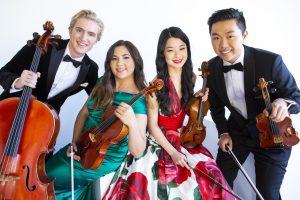
By Ava Figliuzzi
An impeccable attention to detail by the members of the Viano String Quartet was complemented well Feb. 7 by the pin-drop acoustics of the Flagler Museum’s West Room as the group opened the museum’s 2023 music series.
The young Philadelphia-based ensemble holds a residency at the Curtis Institute of Music and won first prize in the 2019 Banff International String Quartet Competition. Their program featured quartets by Haydn (No. 60 in G, Op. 76, No. 1), Schumann (No. 3 in A, Op. 41, No. 3), and Tchaikovsky (No. 1 in D, Op. 11).
Concluding the evening with the Tchaikovsky was a most notable way to end the concert. This work combines exhausting technical demands with a texture that one could mistake for a Tchaikovsky symphony.
John Blades, the museum’s executive director, commented to the audience that this series prides itself on minimal repetition in ensembles and repertoire. This philosophy could explain Tchaikovsky’s presence, although violinist Lucy Wang professed her love for the piece beforehand. Wang, and Viano’s other violinist, Hao Zhou, switched between the first and second violin roles — similar to the renowned Emerson String Quartet. On the Feb. 7 program, Zhou assumed the first violin role for Haydn, and Wang took over for Schumann and Tchaikovsky.
The opening movement (Moderato e simplice) benefited from the quartet’s ability to sustain momentum and match the projection of imitative material when presented in the lower three voices. Already apparent earlier in the program, violist Aiden Kane’s consistent tone and clarity held up the foundation of the quartet and filled out the harmonies with inconspicuous skill. Laudable intonation by the violins was a relief, but the gushing and fiery craze characteristic of Tchaikovsky’s writing seemed too contrived. This effect was one of my only reservations throughout the evening; the quartet reached exhilarating tempos, but the range of characters never seemed to break out of a carefully constructed box.
The Andante cantabile second movement, derived from a Ukrainian folksong, is responsible for the work’s fame. The ensemble deftly reached pristine beauty and refinement, and the air of simple reflection the players brought to the music worked quite well. The punchy motives of the Scherzo were presented skillfully by the violins and not treated over-metronomically, to pleasing effect.
A playful Finale highlighted the unity of the ensemble, and lovely solos featured Kane and cellist Tate Zawadiuk, who tended to shy away from upper registers in lyrical lines. Zawadiuk showed strength instead in virtuosic articulation and precision at faster tempos. Wang braved considerable gymnastics with the outward calm of having an entire section behind her but seemed to rely on the bravura of the other quartet members in the most challenging passage work.
Haydn, the evening’s opener, was admirably played. Phrases in the first movement (Allegro con spirito) were beautifully sculpted by all, and Zhou played with an understated poeticism and exquisite lightness that suited the style. Viano’s delightful execution of the contrast Haydn writes into the first phrase was startling. They led us effortlessly into meticulously thought-out structures, and this orientation was the outstanding aspect of each piece on the program, and should have led listeners to understand the repertoire better.
I would have appreciated an air of spontaneity and unrestrained passion in the Tchaikovsky, but I find well-behaved plans irresistible in Classical repertoire such as the Haydn. Often-covered second violin lines left something to be desired, and Zhou tended towards a sharpness in pitch that gradually improved. Zawadiuk had several shining moments in conversation with Zhou.
Similar to their rendition of Tchaikovsky’s slow movement, the stoic lyricism of Viano allowed the Adagio sostenuto to sing unencumbered by individual ego. In his solo moments, Zhou’s intricate fluxes in color were a pleasure to experience in Flagler’s intimate setting. The only musical dispute I had with the ensemble’s interpretation of Haydn came in the Minuet; delayed gratification of phrase endings at times seemed comedically out of character, despite the quartet members finding obvious enjoyment in the choice.
The Schumann Third Quartet was the centerpiece of the evening. Wang was delicate but yearning in the opening statements of the Allegro molto moderato, and the quartet flowed naturally through the exposition. They adhered to the score by maintaining tempos where many quartets broaden — for example, in the unison, chordal leaps early on. Zawadiuk carried out his solo with a lovely, tender character, but as in Tchaikovsky, he could have blossomed more fully to the high points. Excellent inner voices kept balance and rhythmic control in check. Although Wang’s sound as the first violin was expressive and resonant, Zhou retained his zeal in both the second and first violin parts.
The off-kilter Assai agitato was matter-of-fact — more mystery and bizzareness are present in the writing than was shown by the ensemble. However, all members dispensed estimable energy throughout the variations, and the Tempo risoluto reached a convincing agitato character.
In the third movement, the ensemble sustained a lush, balanced sound, and although I appreciated expressive restraint in Viano’s Haydn, I wanted more rubato and passion from all, especially Wang. When they reached their dynamic peak, I thought it was too soon.
The finale contrasted the posh virtuosity of the primary thematic material with the unrefined, folksy swagger in the Quasi trio section. In contrast to the quartet’s reading of the third movement, I found the intensity build successful in finishing the Schumann.
The Viano String Quartet has much to offer. I will look toward future performances to see if the young members can achieve a broader range of expression, perhaps through a more adventurous repertoire.